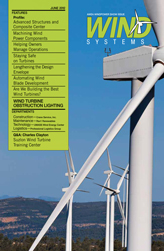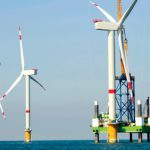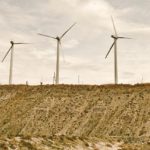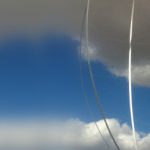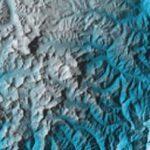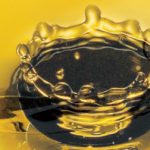With wind energy still in its infancy, currently realizing only a fraction of its potential, manufacturing parts for the industry is a pure growth proposition for many suppliers of machined components. There’s nowhere to go but up, as wind-power is heavily reliant on machined parts and is only gaining traction as a clean energy source. As the industry continues to grow, parts manufacturers have already taken notice of the opportunity, and even the most niche manufacturers are no longer the only game in town. Figure 1
Competitiveness is good for the health of the industry, and suppliers have begun incorporating best practices to produce the best quality, lowest cost and most readily available parts.
Machining wind power components can be intensive, largely depending on the methods and means applied to the metal cutting process. For example: How long do shafts stay on the lathe? How up-to-date are the milling operations and cutters involved? With the sheer volume of holes being drilled, how efficient is the drilling? And how up-to-date is the gear milling process?
Taken as a whole, even otherwise minor improvements in each of these processes can represent a major competitive advantage. Improvements, for example, in tool material, aren’t just a function of durability and reliability, but core to productivity. Advancements in productivity, combined with lengthened tool life, results in faster cycle times and less down time. This factors directly into the ultimate efficiency of a shop, and maximizes capacity and delivery capability.
For instance, developments in the area of insert coatings and substrate have a huge influence on performance. New PVD-grades feature a coating process that, when applied, lowers tensile stresses in the insert by countering with compressive stresses. The high-impact treatment process results in stronger and safer edge lines, sharper cutting edges, and can improve milling processes experiencing difficulty during entry or exit cuts. Also, low stress CVD coatings combined with post-coating treatments result in more wear-resistant inserts. The latest coating and insert technologies can be especially beneficial in high heat applications.
Turning Heads
Turning is such a tried and true staple of the metalworking industry that developments in this area are not as dramatic, especially considering the advancements in milling and the evolution of CNC programming techniques. But behind the scenes, progress has been steadily marching forward.
Turning wind power components involves a straightforward range of operations and demands. The dominant workpiece materials are various alloyed steels and cast iron, many in the form of castings and forgings. And the pieces are big – more than 20 tons. The main shaft, for instance, is a large, uneven forging, typically made of a strong steel alloy. Up to a third of the material is removed through machining, mostly through rough turning. The sheer size of the main shaft dictates long run times, and the operations include everything from heavy-duty rough to finish turning, and each has different demands on tooling. Optimizing this process can yield substantial gains in productivity.
Additional components, such as the slewing ring, can require even harder steel materials. Because both external and internal diameters are machined on vertical lathes, and because stability and fixturing characteristics change, tool choice tends to vary. Sandvik Coromant designed coated inserts that stand up to abrasiveness and high temperatures. This means a harder insert substrate with a coating that provides a good thermal barrier is usually most suitable. That combination aides resistance to plastic deformation and crater wear, and it helps to control natural flank wear while generating long tool life. Figure 2
Successful Hard Part Turning
Hard part turning also has earned a prominent place in hardened material component processes. Many applications that once relied on grinding now fall well within the scope of hard part turning; the old standby only used for certain niche applications. Innovations in machines, component material and hardening, set-ups, and the cutting tools themselves have made turning hard parts increasingly accessible to most machine shops. The transition from grinding to hard part turning presents a considerable suite of advantages gained by switching to a single-edge chip-forming operation.
Case in point, new machining technology has made hard part turning the go-to process for the case-hardened steel realm, especially for turning parts with a hardness range of 55 to 68 HRc. Several wind power components fall within this range – mainly shafts and gearbox wheels – so HPT is an important place to look to improve competitive advantages in wind equipment manufacturing. The process is very much about maximizing productivity, while staying true to a highly precise target spec.
Hardened materials require extremely hard cutting edges. That need is easily fulfilled by cubic boron nitrate (CBN) as the basic tool material. Some degree of edge toughness is also important because of the variance in mechanical loads arising from interrupted cuts or material inclusions. The relationship between the cutting edge geometry and the grade plays a pivotal role in optimizing performance and results. Finding the right combination of CBN grade and edge treatment is the key to successful hard turning operations.
Adaptable Boring
The large diameter holes found on wind power components help to drive the development of a new generation of boring tools. As many wind power components continue to grow larger in size, features like the holes also grow, creating a requirement for new, unique machining processes and tooling solutions.
Consider the machining of large diameter holes in a nodular cast-iron wind power component. Tool strength for roughing and tool stability for finishing are both paramount. These twin qualities are essential for achieving acceptable productivity, predictable tool life, and consistency within the required component tolerances and surface finish levels. The new generation of boring tools can achieve these qualities. Bearing housings, hubs, and gearbox housings are all components that can benefit from new large diameter boring tools. Figure 3
The right insert grade for the operation and materials in wind power housings, be it a roughing or finishing application, is a vital factor in getting the most out of a boring tool. For finishing, inserts having relatively thin PVD coatings on a sharp edge may minimize deflection thus minimizing vibration tendencies. For roughing, a necessary combination is often toughness with a CVD coating that acts as a heat and abrasion-wear barrier. These attributes should be partnered with strong insert geometry to cope with unevenness, interruptions and chip jamming.
Milling: The Workhorse Operation
Milling some of the huge components that constitute wind power equipment requires adherence to best practices to ensure efficiency in throughput and to minimize production costs. The ability to remove material in the most efficient way available and perform various multi-axis operations is crucial to competitive production.
No other machining technique even approaches face milling and square shoulder milling in terms of the sheer volume of material removal. Good milling practices should lead to a satisfactory surface finish, and ultimately a maximum run time for the machine.
With most of the milling workpiece material being some grade of nodular cast iron, several degrees of milling cutter dedication is necessary for good performance, and recent tool developments have been up to the challenge. When face milling a short-chipping material like nodular iron, either a 45- or a 65-degree entering angle is generally regarded as the best option. These angles provide a good combination of feed-rate capability, cutting force balance for long tool-overhang, cutting edge strength and less workpiece frittering that yields optimal results.
Square shoulder milling, edging, profiling and other end milling operations limit the entering angle of the cutter to 90 degrees, necessitating specific properties in the cutter. In the past, lots of square shoulder milling, including end milling, was performed with triangular inserts, as this was the only practical means by which to attain the required edge clearance. The introduction of square inserts presented a problem – improving tool performance was the primary objective, but there had to be four effective edges to provide better tool-cost efficiency.
For the square insert concept to work, it had to have sufficient cutting edge clearance, advanced geometry, and flexible edge lines to perform medium roughing through to the edge-precision for finishing shoulders and angles. Figure 4
Round insert cutters also warrant consideration for roughing operations where the strongest of cutting edges makes a difference to performance and security.
Drilling down
When it comes to wind power components, making efficient holes is an especially competitive capability. The flange of the main shaft, the ring gear, the connecting ring, the gear-box housing, hub and main frame all demand holes, and lots of them. The majority of these holes are relatively shallow, with depths of up to five to seven times the diameter. These components are made of a variety of materials, and tolerances tend not to be as close as other operations require.
Because volume and speed are very important variables, productive hole drilling creates a ripple of positive effects on manufacturing costs and delivery times. These holes fall within the range of indexable insert drills, an area of cutting tool technology that has recently experienced considerable evolution. Today’s short hole drill exhibits excellent penetration rates and finishing capabilities, while being operationally versatile and reliable. Even power requirements have been minimized.
The newest index-able drills have improved cutting action, chip formation and evacuation, machining rates, as well as tool life security and can also generate consistent hole quality.
The application area of indexable insert drills has been considerably broadened over the years, from drills for simple bolt holes to drills for holes designed for thread tapping. Each of these innovations has proven to arrive just in time to directly benefit the manufacture of several key wind power components.
Going Deep
When a holes depth is more than ten times the diameter, it requires specialized technology with standard single- or double-tube systems in place. Some holes may reach depths of 300 x D, and for some wind power components, it’s necessary to machine features deep within those holes. This calls for specially designed tool-movement mechanisms, tool configurations, and cutting edges to make and finish chambers, grooves, screw threads, and cavities.
Drilling the center hole in the main shaft of a wind power unit requires support-pad technology for drill heads. New developments in this area of tooling, along with improvements in insert and head design, have led to innovations in deep hole drilling.
With the right tooling system in place, success is a matter of getting the small adjustments correct, and the devil is in the details. Using the best drill head with the recommended cutting data, a follow-up checklist should include: ensuring the best set-up, having acceptable chip evacuation, maintaining the required surface finish, achieving sufficiently long tool-life, reaching the demanded tolerance consistency, and last-but-not-least, good hole-straightness. Furthermore, alignment between the drill head and the component is integral in avoiding any bell mouthing in the hole.
Next Gen Gear Milling
Wind power is dependent on high-precision gears as a first responder in the transformation from wind energy to electricity, and 90% of gear wheel manufacturing involves gear milling with a disc cutter or hob. A new generation of gear milling tooling moves past traditional high-speed steel to more recent cemented carbide inserts, for improved performance and productivity.
Gear milling’s interrupted nature creates unique obstacles in the amount of entry and exit cuts, and in the high thermal variability seen by the cutting edge. This creates a unique demand combination of edge hardness and toughness.
New generations of steel milling insert grades adapted specifically to gear milling conditions provides a better balance of toughness and wear resistance. Sandvik Coromant’s GC4240 insert grade, for instance, is a tough CVD-coated insert designed for steel milling applications where cutting edge strength is needed to cope with severe machining conditions.
The GC1030 insert, on the other hand, is a PVD-coated insert for applications where a more positive, sharper and tougher cutting-edge line is needed.
Next generation inserts are coupled with disc cutters and hobs engineered for optimal gear milling performance. Versatility is important when it comes to a gear milling product platform – full profile or conventional hobs and roughing or finishing disc cutters – must cover the range of roughing, semi-finishing and finishing applications.
Staying Competitive
The advent of a wind powered age wouldn’t be economically possible if manufacturers weren’t able to cost-effectively create components with precision to close tolerances, and deliver them in a timely manner. That ability owes itself directly to the ongoing evolution of machine tools and tooling solutions. As wind power takes off, competition is increasing for better, faster and less expensive versions of the machined components. The only way to stay competitive is to keep pace with the onward march of progress in tooling, machining and manufacturing equipment and technology. Working with a tooling partner that has an understanding of wind power component production; has an extensive product offering; and the ability and desire to improve and continue to evolve, can make wind power component manufacturing a breeze.



















